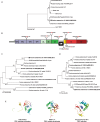Identification of an enterovirus recombinant with a torovirus-like gene insertion during a diarrhea outbreak in fattening pigs
- PMID: 28924489
- PMCID: PMC5591953
- DOI: 10.1093/ve/vex024
Identification of an enterovirus recombinant with a torovirus-like gene insertion during a diarrhea outbreak in fattening pigs
Abstract
Diarrhea outbreaks in pig farms have raised major concerns in Europe and USA, as they can lead to dramatic pig losses. During a suspected outbreak in Belgium of porcine epidemic diarrhea virus (PEDV), we performed viral metagenomics to assess other potential viral pathogens. Although PEDV was detected, its low abundance indicated that other viruses were involved in the outbreak. Interestingly, a porcine bocavirus and several enteroviruses were most abundant in the sample. We also observed the presence of a porcine enterovirus genome with a gene insertion, resembling a C28 peptidase gene found in toroviruses, which was confirmed using re-sequencing, bioinformatics, and proteomics approaches. Moreover, the predicted cleavage sites for the insertion suggest that this gene was being expressed as a single protein, rather than a fused protein. Recombination in enteroviruses has been reported as a major mechanism to generate genetic diversity, but gene insertions across viral families are rather uncommon. Although such inter-family recombinations are rare, our finding suggests that these events may significantly contribute to viral evolution.
Keywords: bocavirus; enterovirus; recombinant virus; viral metagenomics; virome; virus evolution.
Figures



Similar articles
-
First detection of novel enterovirus G recombining a torovirus papain-like protease gene associated with diarrhoea in swine in South Korea.Transbound Emerg Dis. 2019 Mar;66(2):1023-1028. doi: 10.1111/tbed.13073. Epub 2018 Dec 1. Transbound Emerg Dis. 2019. PMID: 30431236 Free PMC article.
-
A Naturally Occurring Recombinant Enterovirus Expresses a Torovirus Deubiquitinase.J Virol. 2017 Jun 26;91(14):e00450-17. doi: 10.1128/JVI.00450-17. Print 2017 Jul 15. J Virol. 2017. PMID: 28490584 Free PMC article.
-
Full-length and defective enterovirus G genomes with distinct torovirus protease insertions are highly prevalent on a Chinese pig farm.Arch Virol. 2018 Sep;163(9):2471-2476. doi: 10.1007/s00705-018-3875-x. Epub 2018 May 21. Arch Virol. 2018. PMID: 29786119
-
[A review of porcine torovirus research: etiology and epidemiology].Bing Du Xue Bao. 2013 Nov;29(6):667-72. Bing Du Xue Bao. 2013. PMID: 24520775 Review. Chinese.
-
Epidemiology of porcine epidemic diarrhea virus among Chinese pig populations: A meta-analysis.Microb Pathog. 2019 Apr;129:43-49. doi: 10.1016/j.micpath.2019.01.017. Epub 2019 Jan 23. Microb Pathog. 2019. PMID: 30682525
Cited by
-
First detection of novel enterovirus G recombining a torovirus papain-like protease gene associated with diarrhoea in swine in South Korea.Transbound Emerg Dis. 2019 Mar;66(2):1023-1028. doi: 10.1111/tbed.13073. Epub 2018 Dec 1. Transbound Emerg Dis. 2019. PMID: 30431236 Free PMC article.
-
First Identification and Pathogenicity Evaluation of an EV-G17 Strain Carrying a Torovirus Papain-like Cysteine Protease (PLCP) Gene in China.Viruses. 2023 Aug 15;15(8):1747. doi: 10.3390/v15081747. Viruses. 2023. PMID: 37632087 Free PMC article.
-
Nanopore sequencing as a revolutionary diagnostic tool for porcine viral enteric disease complexes identifies porcine kobuvirus as an important enteric virus.Sci Rep. 2018 Jun 29;8(1):9830. doi: 10.1038/s41598-018-28180-9. Sci Rep. 2018. PMID: 29959349 Free PMC article.
-
Characterization of Self-Processing Activities and Substrate Specificities of Porcine Torovirus 3C-Like Protease.J Virol. 2020 Sep 29;94(20):e01282-20. doi: 10.1128/JVI.01282-20. Print 2020 Sep 29. J Virol. 2020. PMID: 32727876 Free PMC article.
-
A novel defective recombinant porcine enterovirus G virus carrying a porcine torovirus papain-like cysteine protease gene and a putative anti-apoptosis gene in place of viral structural protein genes.Infect Genet Evol. 2019 Nov;75:103975. doi: 10.1016/j.meegid.2019.103975. Epub 2019 Jul 22. Infect Genet Evol. 2019. PMID: 31344488 Free PMC article.
References
-
- Buchfink B., Xie C., Huson D. H. (2015) ‘Fast and Sensitive Protein Alignment using DIAMOND’, Nature Methods, 12: 59–60. - PubMed
LinkOut - more resources
Full Text Sources
Other Literature Sources

